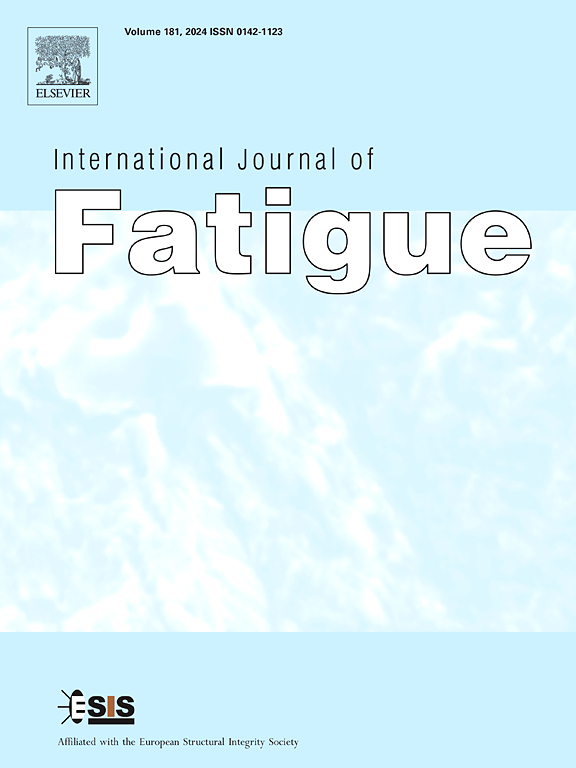增材制造Ti-6Al-4V合金的多尺度建模:从材料到结构水平的疲劳性能评价
IF 6.8
2区 材料科学
Q1 ENGINEERING, MECHANICAL
引用次数: 0
摘要
增材制造(AM) Ti-6Al-4V合金由于其疲劳性能的不确定性,在关键应用中面临限制。尽管对疲劳寿命预测进行了广泛的研究,但AM结构部件和材料级试样之间疲劳行为的差异仍然知之甚少。在本研究中,研究了热等静压(920°C, 1000 bar Ar, 2 h的HIP)对材料和结构水平疲劳性能的影响,旨在弥补AM Ti-6Al-4V合金跨尺度疲劳行为的空白。虽然HIP显著改善了材料级试样的显微组织和疲劳性能,但在结构部件中仍存在较大的近表面缺陷,导致其抗疲劳性能较差。为了定量评估近表面缺陷的影响,提出了一种预测AM Ti-6Al-4V合金疲劳行为的新多尺度模型。该模型将有限元分析与微观组织特征相结合,通过晶界之间的距离和相邻晶粒之间的取向偏差来量化晶界效应。该模型的输入只需要材料的试验条件、拉伸性能和微观结构信息。利用材料和结构两级轴向疲劳试验的S-N数据对模型进行了验证,结果表明预测结果与试验结果具有良好的相关性。总的来说,本研究增强了对增材制造合金的加工工艺、显微组织和疲劳性能之间关系的理解。此外,它还提供了一个集成微观结构、材料和结构信息的多尺度分析框架,为耐疲劳增材制造部件的准确预测和设计提供了基础。本文章由计算机程序翻译,如有差异,请以英文原文为准。

Multiscale modelling of additively manufactured Ti-6Al-4V alloy: Fatigue performance evaluation from material to structural level
Additively manufactured (AM) Ti-6Al-4V alloys face limitations in critical applications due to uncertainties in their fatigue performance. Despite extensive research on fatigue life prediction, the discrepancies in fatigue behaviour between AM structural components and material-level specimens remain poorly understood. In this study, the effect of hot isostatic pressing (HIP at 920 °C, 1000 bar Ar, 2 h) on the fatigue properties at both material and structural levels was investigated, aiming to bridge the gap in the cross-scale fatigue behaviour of AM Ti-6Al-4V alloys. Although HIP significantly improved microstructure and fatigue performance of material-level specimens, the presence of larger near-surface defects remained in the structural components, resulting in a poorer fatigue resistance. To quantitatively evaluate the impact of near-surface defects, a novel multiscale model for predicting fatigue behaviour of AM Ti-6Al-4V alloys was proposed. The model integrates finite element analysis with microstructural characteristics, where the grain boundaries (GBs) effect was quantified by the distance between GBs and the misorientations between adjacent grains. The input of this model requires only test conditions, tensile properties and microstructural information of the materials. The model was validated using S-N data from axial fatigue tests at both the material and structural levels, showing excellent correlation between predicted and experimental results. Overall, this study enhances the understanding of the relationship between processing techniques, microstructure and fatigue performance in AM alloys. Furthermore, it provides a multiscale analysis framework that integrates microstructural, material and structural information, offering a basis for the accurate prediction and design of fatigue-resistant AM components.
求助全文
通过发布文献求助,成功后即可免费获取论文全文。
去求助
来源期刊

International Journal of Fatigue
工程技术-材料科学:综合
CiteScore
10.70
自引率
21.70%
发文量
619
审稿时长
58 days
期刊介绍:
Typical subjects discussed in International Journal of Fatigue address:
Novel fatigue testing and characterization methods (new kinds of fatigue tests, critical evaluation of existing methods, in situ measurement of fatigue degradation, non-contact field measurements)
Multiaxial fatigue and complex loading effects of materials and structures, exploring state-of-the-art concepts in degradation under cyclic loading
Fatigue in the very high cycle regime, including failure mode transitions from surface to subsurface, effects of surface treatment, processing, and loading conditions
Modeling (including degradation processes and related driving forces, multiscale/multi-resolution methods, computational hierarchical and concurrent methods for coupled component and material responses, novel methods for notch root analysis, fracture mechanics, damage mechanics, crack growth kinetics, life prediction and durability, and prediction of stochastic fatigue behavior reflecting microstructure and service conditions)
Models for early stages of fatigue crack formation and growth that explicitly consider microstructure and relevant materials science aspects
Understanding the influence or manufacturing and processing route on fatigue degradation, and embedding this understanding in more predictive schemes for mitigation and design against fatigue
Prognosis and damage state awareness (including sensors, monitoring, methodology, interactive control, accelerated methods, data interpretation)
Applications of technologies associated with fatigue and their implications for structural integrity and reliability. This includes issues related to design, operation and maintenance, i.e., life cycle engineering
Smart materials and structures that can sense and mitigate fatigue degradation
Fatigue of devices and structures at small scales, including effects of process route and surfaces/interfaces.
 求助内容:
求助内容: 应助结果提醒方式:
应助结果提醒方式:


